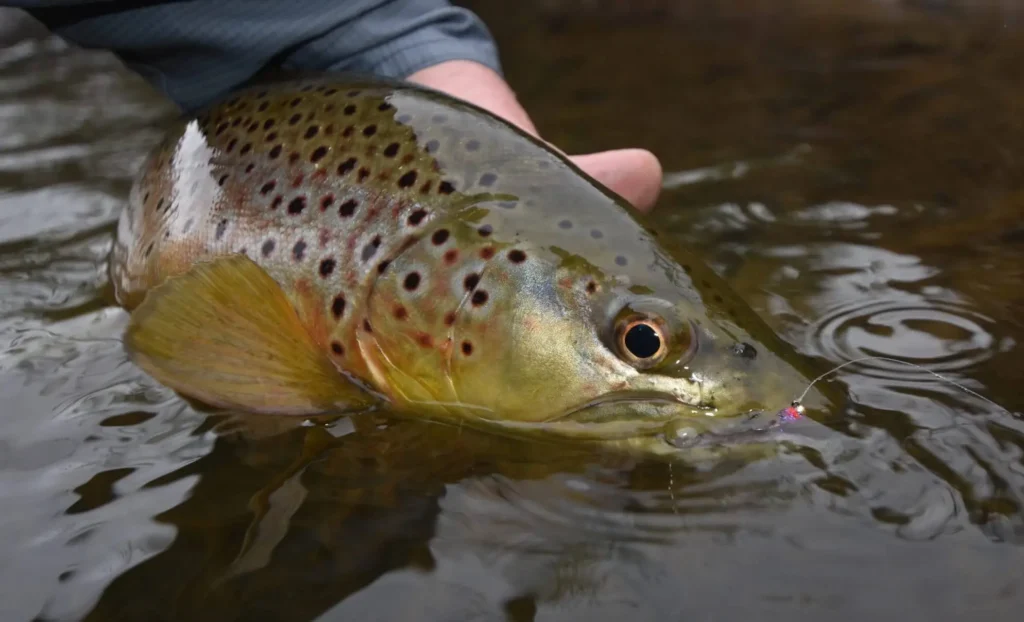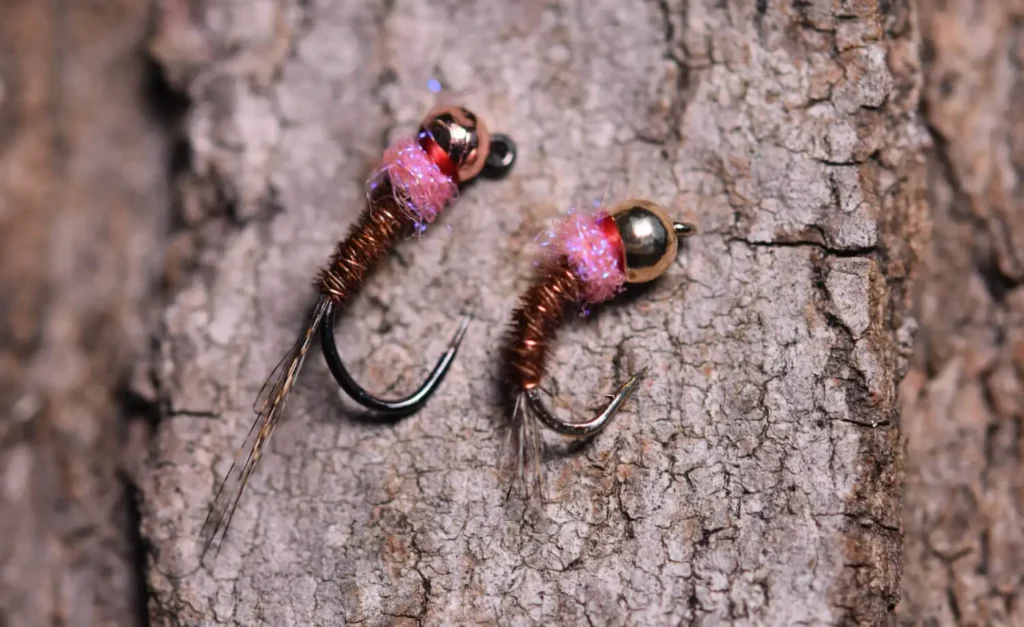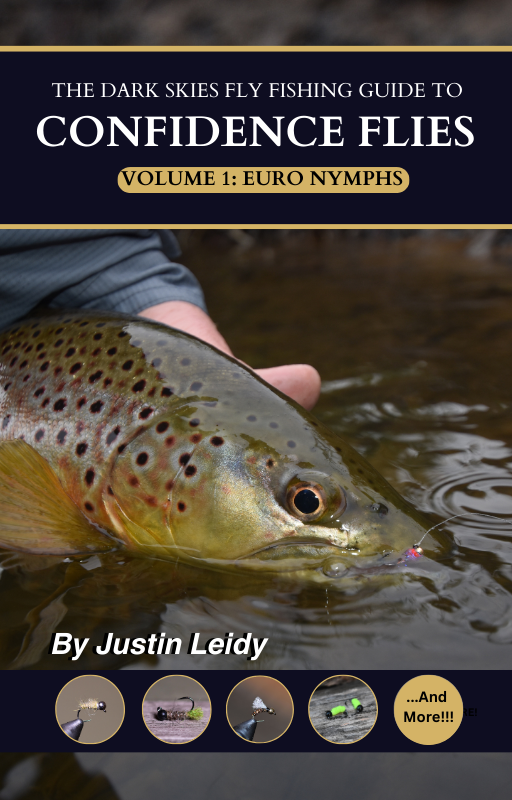Fishing and Tying the Frenchie Fly

The Frenchie is the first Euro nymphing-specific pattern that I ever encountered. As a matter of fact, the Frenchie fly is so similar to Frank Sawyer’s Pheasant Tail Nymph that only the addition of a hotspot and heavy weight really separates it from the original.
From what I’ve read, Lance Egan developed, or introduced this pattern, to North America. Egan is among the most renowned and accomplished American competitive fly fishermen and is a multi-time national champion and world championship medalist with Team USA. He is credited as the developer of the Frenchie, and inspiration for creating this fly came from observing the patterns that European competitors were fishing that included hotspots.
There are several qualities Egan took into account that cause the Frenchie to be so effective. First, the super slim profile coupled with a heavy tungsten bead helps this smallish fly reach the stream bottom quickly. Second, as discussed earlier, flies tied with pheasant tail flat out catch trout, period. Finally, the customizable hotspot provides that small, flashy element that grabs the attention of wild trout causing them to take it readily.
Fishing the Frenchie Fly
My Frenchies of preference call for natural pheasant tail bodies with either the original salmon pink or caddis green hotspot. My friend Ralph finds great success using Frenchies tied with hot pink and light olive collars, and he has written about the Frenchie on this website in the past. He also ties Frenchies with a white hotspot and uses these from mid-May to mid-June when the Cahills are active in northcentral Pennsylvania.
This past March, I nymphed a small Cameron County Class A tributary that is exclusively a native brookie fishery. In two and a half hours, I landed nearly twenty fish on a #16 Frenchie, missing many more. Later that same spring, in early June, I was on a northwestern PA tailwater that is known for being a real “sumbitch” that does not give up trout easily. I ended up landing ten trout that day including a bruiser stocked rainbow and a number of small wild browns. All but one of the fish I caught ate a #16 Frenchie tied in the original style that was being fished as a tag fly.
Incidentally, the Frenchie Fly might be the only pattern that I fish regularly as both a point and tag fly in a tandem rig. I also regularly fish a Frenchie by itself on a single fly setup. Versatility is what makes this fly pattern truly shine.
Another advantage of the Frenchie is that it is unequivocally customizable. The hotspot collar can be tied in a nearly unlimited host of colors, and the pheasant tail body can be customized to match the local insects on favorite waterways. For example, using dyed yellow or orange pheasant tail for the body might be a good choice to imitate sulphur nymphs. Deep olive or black dyed pheasant tail are likely choices for BWO nymphs. The choices and combinations are seemingly endless.

Tying the Frenchie Fly
- Size 12-18 jig-style hook. The Model 20 available through Wholesale Fly Company is a great hook at an exceptional price. The Fulling Mill 5045 is another great option, but keep in mind that Fulling Mill hooks typically run one full size larger than most brands. Another great hook option for this pattern is a 1X short caddis-style hook such as the Model 10 from Wholesale Fly Company.
- Tungsten beads of your choice. Gold is a great color for this pattern, but also try tying it with copper. Use Tungsten beads of your choice for jig-style hooks and regular rounded tungsten beads for standard hooks.
- Tail: 5-6 fibers of Coq De Leon or pheasant tail fibers. The original pattern calls for Light Speckled Pardo CDL, but any color will work.
- Natural pheasant tail is the most common to use for the body, but also consider yellow-dyed pheasant tail for tying up a sulphur imitation of the Frenchie.
- Ribbing: XS wire ribbing to match the color of the bead.
- Thorax/collar: UV dubbing. Great options are pink, salmon pink, olive, white, orange, and purple.
- Red SemperFli thread in 8/0 for larger sizes and 12/0 for smaller sizes.

To spin up a Frenchie, place a slotted tungsten bead of color choice on the hook. If tying a large, #14 Frenchie, I add a few wraps of lead wire behind the bead so that I can use it as a heavier, anchor fly. However, for #16 and #18 flies, I omit the lead underbody because I want to keep the profile very slim and not create increased bulk.
Build a thread base on the hook shank and begin by tying in 5 or 6 fibers of CDL for the tail. I have used pheasant tail fibers for the tail, too, with equal success. Next, tie in 3-8 pheasant fibers, depending on hook size, for the body and the XS wire rib. Tie in the pheasant tail by the tips, and if need be, clip off the brittle ends of the tips so that they don’t break while wrapping the body.
Using hackle pliers, wrap the pheasant tail two-thirds up the hook shank, carefully twisting as you go to create a segmented look and increased durability. Counter wrap the wire, trap with thread, and trim. Build a narrow hotspot of bright-colored UV dubbing in the color and brand of your choice and create a thread collar by whip finishing
It’s easy to make the Frenchie bulky, so be aware of how many pheasant tail fibers you use for the body. Try to keep the body slim.
This pattern can be tied on a jig nymph hook or it can be tied on a curved caddis hook in the same sizes. Both variations are equally effective.
Tie in a variety of sizes with different sized beads to cover any situation you might encounter. The Frenchie is a true confidence pattern that works everywhere!
Did You Find This Fly Tying Guide Helpful?
Stay up to date with the Dark Skies Fly Fishing monthly newsletter for free and receive the latest posts in fly fishing news, tricks, tips, and techniques, stream reports, as well as updates on new flies added to the Online Store and exclusive discounts!
Sign Up NowDownload our eBook "Confidence Flies: Volume One, Euro Nymphs" for free today when you sign up for our newsletter!

Have a fly fishing question you’d like answered? Drop us a line at info@darkskskiesflyfishing.com! If we use your question in a blog post or in the newsletter, we’ll send you a FREE fly box with a dozen of our favorite nymphs and dry flies!
